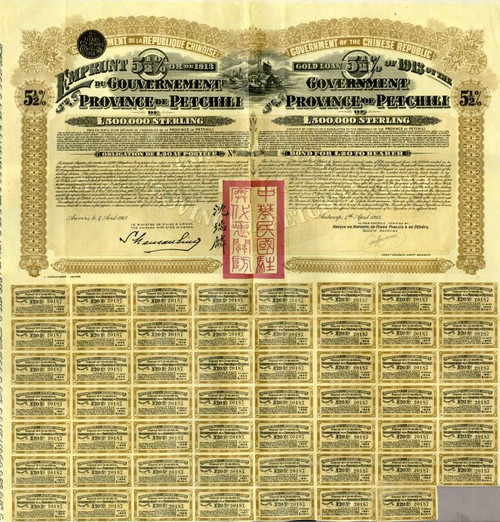$50 United States Dollar Bond (Liberty Bonds) - The 27th Year Gold Loan of the Republic of China - 1938. 19 Coupons Attached. Extremely Fine. PASS-CO authenticated.
Bonds were part of an initial $50,000,000 bond issue, redeemable at par with the U.S. Dollar.
These bonds were issued to help China during the Second Sino-Japanese War.


The Second Sino-Japanese War was the war fought between the Republic of China and the Empire of Japan from 1937 to 1945 as part of World War II. It is often regarded as the beginning of World War II in Asia. It was the largest Asian war in the 20th century and has been described as "the Asian Holocaust", in reference to the scale of Japanese war crimes against Chinese civilians. It is known in Japan as the Second China–Japan War, and in China as the Chinese War of Resistance against Japanese Aggression.
On 18 September 1931, the Japanese staged a false flag event known as the Mukden Incident, a pretext they fabricated to justify their invasion of Manchuria. This is sometimes marked as the beginning of the war.[29][30] From 1931 to 1937, China and Japan engaged in skirmishes in mainland China. Japan achieved major victories, capturing Beijing and Shanghai by 1937. Despite having fought each other in the Chinese Civil War since 1927, the Communists and Nationalists formed the Second United Front in late 1936 to resist the Japanese invasion together.
Tensions escalated after what would become the first battle of the war - the Marco Polo Bridge incident on 7 July 1937, in which the Japanese and Chinese opened fire upon each other after a Japanese soldier went missing. This prompted a full-scale Japanese invasion of the rest of China. This incident is widely regarded as the start of the Second Sino-Japanese War, and the Pacific theater of World War II.
The Japanese captured the Chinese capital of Nanjing in 1937, which led to the Nanjing Massacre, also known as the Rape of Nanjing. After failing to stop the Japanese in the Battle of Wuhan, the Chinese central government relocated to Chongqing in the Chinese interior. Following the Sino-Soviet Non-Aggression Pact, material support bolstered the Republic of China Army and Air Force.
By 1939, after Chinese victories in Changsha and Guangxi, and with Japan's lines of communications stretched deep into the Chinese interior, the war reached a stalemate. The Japanese were unable to defeat Chinese Communist Party (CCP) forces in Shaanxi, who waged a campaign of sabotage and guerrilla warfare. In November 1939, Chinese nationalist forces launched a large scale winter offensive, and in August 1940, CCP forces launched an offensive in central China.
In December 1941, Japan launched its surprise attack on Pearl Harbor and declared war on the United States. The US increased aid to China: the Lend-Lease act gave China a total of $1.6 billion (equivalent to $20 billion in 2023). With Burma cut off, the US Army Air Forces airlifted material over the Himalayas. In 1944, Japan launched Operation Ichi-Go, the invasion of Henan and Changsha. In 1945, the Chinese Expeditionary Force resumed its advance in Burma and completed the Ledo Road linking India to China. China launched large counteroffensives in South China and repulsed a failed Japanese invasion of West Hunan and recaptured Japanese occupied regions of Guangxi.
Japan formally surrendered on 2 September 1945, following the atomic bombings of Hiroshima and Nagasaki, Soviet declaration of war and subsequent invasions of Manchukuo and Korea. The war resulted in the deaths of around 20 million people, mostly civilians. China was recognized as one of the Big Four Allies, regained all territories lost, and became one of the five permanent members of the United Nations Security Council. The Chinese Civil War resumed in 1946, ending with a communist victory, which established the People's Republic of China.









